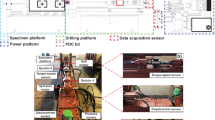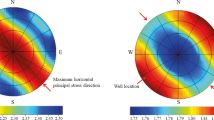Abstract
Understanding the relations between drilling response parameters (drilling speed, axial thrust force and torque, etc.) and rock properties is useful to quickly acquire lithology parameters (rock strength and brittleness, etc.) and dynamically grasp the characteristics of drilling conditions. In this present study, a small-scale core drilling platform was designed to simulate the diamond drilling process in four types of rocks (sandstone, marble, limestone and granite). Moreover, mechanical sensors were developed to dynamically monitor drilling response parameters (axial thrust force, displacement, oil pressure, torque and rotation speed) of drill bits during drilling in rocks. Experimental results indicated that torque and axial thrust force had a positive correlation with rock strength (uniaxial compressive strength (UCS) and tensile strength), while drilling speed was negatively correlated with rock strength. Conversely, the axial thrust force and the torque had a negative correlation with the Brittleness, and the drilling speed was positively correlated with the Brittleness. Based on the investigations on drilling parameters versus time and drilling depth, it could be concluded that, due to the wear and vibration of drill bits, the drilling speed and the axial thrust force decreased, while the torque increased with the increase of rotation speed. The drilling speed with respect to homogeneous lithology was uniform. The average drilling speeds in sandstone, marble and granite at a rotation speed of 300 r/min were 1.9 mm/s, 1.38 mm/s and 0.79 mm/s, respectively. Notably, at a rotation speed of 300 r/min, the relationships between drilling parameters and lithology parameters were established, and the feasibility of this method to understand lithology parameters via drilling parameters was verified. The conclusions obtained can provide an important reference for the dynamic monitoring scheme of rock drilling response parameters in field construction.
Highlights
-
A convenient test apparatus used to measure lithology parameters while drilling is designed.
-
A PTR sensor which can simultaneously measure drilling pressure, torque and rotation speed is developed.
-
Three models based on drilling parameters for predicting rock strength are presented.
-
Providing a reference scheme for comprehensive measurement of rock drilling parameters.







Similar content being viewed by others
Data Availability Statement
All data used in this study are true and reliable, it can be freely available through open data portals online.
References
Altindag R (2002) The evaluation of rock brittleness concept on rotary blast hole drills. J South Afr Inst Min Metall 102(1):61–66
Cao RY, Wang YJ, Zhao YF, Wang XG, He SW, Peng LJ (2021) In-situ tests on quantitative evaluation of rock mass integrity based on drilling process index. Chin J Geotech Eng 43(4):679–687
Darling P (2011). SME Mining Engineering Handbook (Vol. 1). SME.
de la Vergne JN (2003) Hard rock miner’s handbook, edition 5. Ground Water 15:100
Dong FZ, Zhang ZJ, Wang H, Zhang MX, Wang XF (2019) Evaluation of rock-mass block index (RBI) based on drilling process monitor (DPM). Geotech Investig Surv 1:7–12
Evans I (1962) The force required to cut coal with blunt wedges. Int J Rock Mech Min Sci Geomech Abst 2(1):1–12
Gao W, Yue ZQ, Li AG (2012) Discussion on the application of automatic drilling process monitoring in site investigation. Geotech Investig Surv 2:27–32
Gui MW, Soga K, Bolton MD (2002) Instrumented borehole drilling for subsurface investigation. J Geotech Geoenviron Eng 128(4):283–291
Huang SL, Wang ZW (1997) The mechanics of diamond core drilling of rocks. Int J Rock Mech Min Sci 34:3–4
Jimeno CL, Jimeno EL, Carcedo FJA (1995) Drilling and blasting of rocks. Taylor and Francis, New York
Kalantari S, Hashemolhosseini H, Baghbanan A (2018) Estimating rock strength parameters using drilling data. Int J Rock Mech Min Sci 104:10445–10452
Li HY, Zhang YC, Wu J, Zhang XYL, Zhang W, Li ZF (2020a) Grouting sealing mechanism of water gushing in karst pipelines and engineering application. Constr Build Mater 254:119250
Li YL, She L, Wen LF, Zhang Q (2020b) Sensitivity analysis of drilling parameters in rock rotary drilling process based on orthogonal test method. Eng Geol 270:105576
Li W, Huang GL, Yu F, Ni HJ, Jiang W, Zhang XB (2020c) Modeling and numerical study on drillstring lateral vibration for air drilling in highly-deviated wells. J Petrol Sci Eng 195:107913
Liu TX, Zhou J, Liang L, Zhao Y, Cao DQ (2021) A novel torque analysis method for drilling deep lunar soil by DEM. J Terrramech 94:23–37
Ma YC, Huang ZQ, Li Q, Zhou Y, Peng SJ (2018) Cutter layout optimization for reduction of lateral force on PDC bit using Kriging and particle swarm optimization methods. J Petrol Sci Eng 163:359–370
Manzoor S, Liaghat S, Gustafson A, Johansson D, Schunnesson H (2020) Establishing relationships between structural data from close-range terrestrial digital photogrammetry and measurement while drilling data. Eng Geol 267:105480
Meng FZ, Wong LNY, Zhou H (2021) Rock brittleness indices and their applications to different fields of rock engineering: a review. J Rock Mech Geotech Eng 13:221–247
Navarro J, Schunnesson H, Ghosh R, Segarra P, Johansson D, Sanchidrian JA (2019) Application of drill-monitoring for chargeability assessment in sublevel caving. Int J Rock Mech Min Sci 119:180–192
Pandey AK, Jain AK, Singh DP (1991) An investigation into rock drilling. Int J Min Reclam Env 5:135–141
Persson PA, Holmberg R, Lee J (2018) Rock blasting and explosives engineering. CRC Press
Pryhorovska TO, Chaplinskiy SS, Kudriavtsev IO (2015) Finite element modelling of rock mass cutting by cutters for PDC drill bits. Pet Explor Dev 42(6):812–816
Raïs K, Kara M, Garde L, Hadji R, Khochman L (2017) Original approach for the drilling process optimization in open cast mines; case study of Kef Essenoun open pit mine Northeast of Algeria. Min Sci 24:147–159
Richard T, Dagrain F, Poyol E, Detoutnay E (2012) Rock strength determination from scratch tests. Eng Geol 147–148(12):91–100
Rodgers M, McVay M, Horhota D, Hernando J, Paris J (2020) Measuring while drilling in Florida limestone for geotechnical site investigation. Can Geotech J 57(11):1733–1744
Schunnesson H (1996) RQD predictions based on drill performance parameters. Tunn Undergr Space Technol 11(3):345–351
Schunnesson H (1998) Rock characteristics using percussive drilling. Int J Rock Mech Min Sci 35(6):711–725
Somerton WH (1959) A laboratory study of rock breakage by rotary drilling, transaction of American Institute of Mining. Metall Petrol Eng 216:92–97
Teale R (1965) The concept of specific energy in rock drilling. Int Rock Mech Min Sci 2(1):57–63
Van Eldert, Schunnesson H, Johansson D, Saiang D (2018) Measurement While Drilling (MWD) technology for blasting damage calculation. 12th International Symposium on Rock Fragmentation by Blasting (Fragblast 12), 11–13 June, 2018, Luleå University of Technology, Luleå, Sweden
Van Eldert J, Schunnesson H, Saiang D, Funehag J (2020a) Improved filtering and normalizing of Measurement-While-Drilling (MWD) data in tunnel excavation. Tunn Undergr Space Technol 103:103467
Van Eldert J, Schunnesson H, Johansson D, Saiang D (2020b) Application of measurement while drilling technology to predict rock mass quality and rock support for tunneling. Rock Mech Rock Eng 53:1349–1358
Wang CH, Gao GY, Yang SX, Yao R, Huang LY (2019a) Analysis and prediction of stress fields of Sichuan—Tibet railway area based on contemporary tectonic stress field zoning in Western China. Chin J Rock Mech Eng 38(11):2242–2252
Wang Q, Sun HB, Jiang B, Gao S, Li SC, Gao HK (2019b) A method for predicting uniaxial compressive strength of rock mass based on digital drilling test technology and support vector machine. Rock Soil Mech 40(3):1221–1228
Wang Q, Gao HK, Jiang ZH, Li SC, Jiang B (2020) Development and application of a surrounding rock digital drilling test system of underground engineering. Chin J Rock Mech Eng 39(2):301–310
Warren TM, Armagost WK (1988) Laboratory drilling performance of PDC bits. SPE Drill Eng 3(2):125–135
Xu XH, Yu J (1984) Rock fracture science. Coal Industry Press, pp 962–970
Xu WT, Zhang YS, Li XZ, Wang XY, Ma F, Zhao JB, Zhang Y (2020) Extraction and statistics of discontinuity orientation and trace length from typical fractured rock mass: a case study of the Xinchang underground research laboratory site, China. Eng Geol 269:105553
Xu WT, Zhang YS, Li XZ, Wang XY, Liu RC, Zhao P, Zhang Y, Dai JL (2021) Comprehensive identification of statistical homogeneity of fractured rock masses for a candidate HLW repository site, China. Eng Geol 293:106279
Yan TN (2014) Geotechnical drilling technology. Central South University Press, pp 33–36
Yarali O, Soyer E (2013) Assessment of relationships between drilling rate index and mechanical properties of rocks. Tunn Undergr Space Technol 33:46–53
Yue ZQ (2014) Drilling process monitoring for refining and upgrading rock mass quality classification methods. Chin J Rock Mech Eng 33(10):1997–1996
Yue ZQ, Lee CF, Law KT, Tham LG (2004) Automatic monitoring of rotary-percussive drilling for ground characterization—illustrated by a case example in Hong Kong. Int J Rock Mech Min Sci 41(4):573–612
Yue ZQ, Gao W, Chen J, Lee CF (2006) Drilling process monitoring for a wealth of extra factual data from drill hole site investigation. In: Proceedings of the 10th International Congress of the International Association of Engineering Geology (IAEG2006 Engineering Geology for Tomorrow’s Cities), pp 1–10
Zeng JQ, Wang YJ, Cao RL, Zhao YF (2017) Drilling process monitoring-based study on granite drilling specific energy. Water Resour Hydropower Eng 48:112–117
Zhang QY, Liu CC, Duan K, Zhang ZJ, Xiang W (2020) True three-dimensional geomechanical model tests for stability analysis of surrounding rock during the excavation of a deep underground laboratory. Rock Mech Rock Eng 53:517–537
Zheng WQ (1988) Several factors affect drilling efficiency. Min Mach 16–18
Acknowledgements
This research is supported by the Xuzhou Science and Technology Plan Social Development Key Special Project (SHFZZDZX20210017).
Author information
Authors and Affiliations
Contributions
LCD, XZL, WTX, LQ, and PZ conceptualized the study. LCD, XZL and WTX conducted the data acquisition, preparation, and analysis. All authors contributed to the interpretation of results and manuscript preparation.
Corresponding authors
Ethics declarations
Conflict of Interest
The authors declare that they have no conflict of interest.
Additional information
Publisher's Note
Springer Nature remains neutral with regard to jurisdictional claims in published maps and institutional affiliations.
Rights and permissions
About this article
Cite this article
Deng, LC., Li, XZ., Xu, W. et al. Integrated Monitoring of Lithology Parameters While Drilling in Small-Scale Coring Platform. Rock Mech Rock Eng 55, 7269–7288 (2022). https://doi.org/10.1007/s00603-022-02998-2
Received:
Accepted:
Published:
Issue Date:
DOI: https://doi.org/10.1007/s00603-022-02998-2









